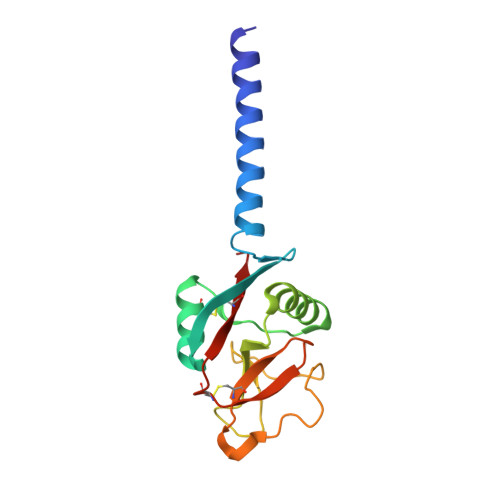Molecular basis of sugar recognition by collectin-K1 and the effects of mutations associated with 3MC syndrome.
Girija, U.V., Furze, C.M., Gingras, A.R., Yoshizaki, T., Ohtani, K., Marshall, J.E., Wallis, A.K., Schwaeble, W.J., El-Mezgueldi, M., Mitchell, D.A., Moody, P.C., Wakamiya, N., Wallis, R.(2015) BMC Biol 13: 27-27
- PubMed: 25912189
- DOI: https://doi.org/10.1186/s12915-015-0136-2
- Primary Citation of Related Structures:
4YLI, 4YMD - PubMed Abstract:
Collectin-K1 (CL-K1, or CL-11) is a multifunctional Ca(2+)-dependent lectin with roles in innate immunity, apoptosis and embryogenesis. It binds to carbohydrates on pathogens to activate the lectin pathway of complement and together with its associated serine protease MASP-3 serves as a guidance cue for neural crest development. High serum levels are associated with disseminated intravascular coagulation, where spontaneous clotting can lead to multiple organ failure. Autosomal mutations in the CL-K1 or MASP-3 genes cause a developmental disorder called 3MC (Carnevale, Mingarelli, Malpuech and Michels) syndrome, characterised by facial, genital, renal and limb abnormalities. One of these mutations (Gly(204)Ser in the CL-K1 gene) is associated with undetectable levels of protein in the serum of affected individuals. In this study, we show that CL-K1 primarily targets a subset of high-mannose oligosaccharides present on both self- and non-self structures, and provide the structural basis for its ligand specificity. We also demonstrate that three disease-associated mutations prevent secretion of CL-K1 from mammalian cells, accounting for the protein deficiency observed in patients. Interestingly, none of the mutations prevent folding or oligomerization of recombinant fragments containing the mutations in vitro. Instead, they prevent Ca(2+) binding by the carbohydrate-recognition domains of CL-K1. We propose that failure to bind Ca(2+) during biosynthesis leads to structural defects that prevent secretion of CL-K1, thus providing a molecular explanation of the genetic disorder. We have established the sugar specificity of CL-K1 and demonstrated that it targets high-mannose oligosaccharides on self- and non-self structures via an extended binding site which recognises the terminal two mannose residues of the carbohydrate ligand. We have also shown that mutations associated with a rare developmental disorder called 3MC syndrome prevent the secretion of CL-K1, probably as a result of structural defects caused by disruption of Ca(2+) binding during biosynthesis.
- Department of Infection, Immunity and Inflammation, University of Leicester, Leicester, LE1 9HN, UK. uvg1@leicester.ac.uk.
Organizational Affiliation:




















